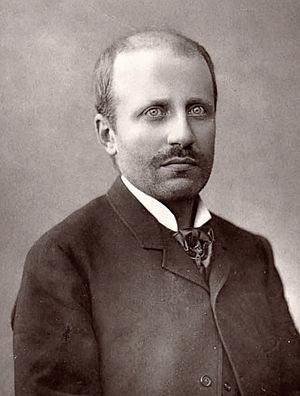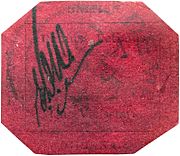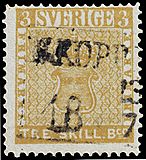Philipp von Ferrary facts for kids
Quick facts for kids
Philipp von Ferrary
|
|
|---|---|

Philipp von Ferrary
|
|
| Born | January 11, 1850 |
| Died | May 20, 1917 (aged 67) |
| Nationality | French, Austrian |
| Occupation | Stamp collector |
Philipp von Ferrary (born January 11, 1850 – died May 20, 1917) was a famous stamp collector from France. He built what might be the most complete stamp collection ever. It included super rare stamps like the unique Treskilling Yellow from Sweden and the 1856 one-cent "Black on Magenta" from British Guiana.
Ferrary was born into an Italian family. He became a French citizen in 1871. Later, he became an Austrian citizen. This change was important because France and Austria were enemies during World War I. After Ferrary died in 1917, the French government took his stamp collection. They later sold it because he was an Austrian citizen, and Austria was an enemy country. Ferrary also supported Germany, which was another reason he could not return to France during the war.
When Ferrary's mother left Paris, she gave the Hôtel Matignon to be used as the embassy for Austria-Hungary. She made sure her son could keep a large apartment there for his whole life. This building is now where the Prime Minister of France lives. Ferrary died in Lausanne, Switzerland, in May 1917. He was buried in Steinbach am Attersee in Austria. His stamp collection is still thought to be one of the greatest ever.
Contents
Early Life and Family
Ferrary was born in the grand Hôtel Matignon in Paris. He lived there for most of his life. This building was once a fancy place for parties. Today, it is the official home of the French Prime Minister.
Ferrary was the son of the Duke and Duchess of Galliera. His father, Raffaele de Ferrari, came from a very old and rich family of bankers. He was a successful businessman. He helped start a big bank called Crédit Mobilier. This bank helped pay for many large projects in the 1800s. These projects included railroads in Europe and the digging of the Suez Canal.
Ferrary's mother, Duchess Maria de Brignole-Sale, was related to the Princess of Monaco. After Ferrary's father died, his mother offered part of their home, the Hôtel Matignon, to the future King of France. But she soon became unhappy with the political situation and left Paris. She then gave the Hôtel Matignon to the Austro-Hungarian Emperor to use as an embassy.
When his father died, Ferrary gave up all his noble titles. He was then adopted by an Austrian count and became an Austrian citizen. He preferred to be called "Philipp von Ferrary." Stamp collectors and dealers often just called him "Ferrary."
Changing Nationalities
Philipp von Ferrary changed his nationality more than once. He was born in France with Italian family roots. In 1871, he became a French citizen. After his father died in 1876, he was adopted by an Austrian count and became an Austrian citizen. In 1885, he officially gained the right to live in Braunau, Austria, which was like becoming an Austrian citizen. In 1908, he also became a Swiss citizen, but he remained an Austrian national.
When World War I started, Ferrary was in Holland. Because he was an Austrian citizen, he could not go back to France. Some records suggest he might have visited Paris in 1916. This would have been the last time he saw his amazing stamp collection.
The Collection is Seized
France took his stamp collection as "war reparations." This meant they took it to help pay for the damages of the war. They did this because Ferrary was an Austrian citizen, and Austria was an enemy country. Ferrary had also openly supported Germany, calling it "his dear country."
His collection was taken under the rules of the Treaty of Versailles. This treaty officially ended World War I. The collection was sold off after Ferrary's death, from 1921 to 1926. The money from the sales was used to reduce the money Germany owed France for war damages. For example, the famous one-cent magenta stamp was sold in 1922 to an American collector named Arthur Hind.
His Amazing Stamp Collection
Ferrary started collecting stamps when he was young. He later inherited a huge amount of money, about 120 million French francs. He used this money to buy rare stamps and coins. Many people believe his stamp collection was the greatest ever put together. It might never be matched.
Among his incredibly rare stamps were the unique Treskilling Yellow from Sweden. He also owned the 1856 one-cent "Black on Magenta" from British Guiana. He bought this stamp in 1878 for £150. After his death, it sold for $36,000 in 1924.
He also owned the only unused copy of the Two Cent Hawaii Missionary of 1851. Another special item he owned was the only known envelope with both values of the first Mauritius "Post Office" stamps. This is often called "the greatest item in all philately."
Ferrary bought many important older collections. He spent a lot of money each year on stamps. A company called Stanley Gibbons said he spent about £3,000 to £4,000 a year with them.
He hired Pierre Mahé, a top stamp dealer in Paris, to help him manage his collection. Mahé worked for him from 1874 until he died in 1913. Ferrary also had two secretaries. One looked after his stamps, and the other handled postcards and envelopes. He had a special stamp room with many cabinets to store his collection.
Even though he lived in Paris, Ferrary traveled often. He met with stamp dealers everywhere he went. He often paid them in gold right away. He bought stamps without worrying about the price. Because of this, some dealers and people who made fake stamps took advantage of him. Very good fake stamps were even called "Ferrarities."
Coin Collecting
Ferrary also collected a large number of rare coins. His collection of British coins was sold in London over five days in 1922. The sale catalog did not use his name. It just said the coins belonged to "a Nobleman, Recently Deceased." Other sales of his French and ancient coins were held in Paris.
The "Nobleman" Sales
Ferrary wanted his amazing collection to be seen by the public. In his will, written in 1915, he left his collection to "the German nation." He wanted it to be shown in the Postmuseum in Berlin. He also left money for its care. He said the collection should not be mixed with the museum's other items. He wanted it to be shown in its own special room.
But because he was an Austrian citizen living in France, World War I put him in danger. He left his many stamp albums at the Austrian embassy. He then went to Vienna in early 1915 and later to Switzerland. He died there soon after. So, he never saw his life's work taken apart after the war.
The French government took Ferrary's collection. They claimed it as war reparations. This huge collection was sold off in 14 separate sales between 1921 and 1926. It brought in about 30 million francs.
These sales allowed other famous collectors to buy some of the rarest stamps known. This helped the hobby of stamp collecting grow in the early 1900s. For example, the British Guiana 1c magenta was bought by American collector Arthur Hind. He even outbid King George V of the United Kingdom.
The Treskilling Yellow error stamp from Sweden was bought by King Carol II of Romania in 1937. The "Bordeaux cover" with Mauritius "Post Office" stamps was bought by several famous collectors. These included Arthur Hind and Alfred F. Lichtenstein. Lichtenstein also bought the only unused copy of the 2 cent Hawaiian Missionaries stamp, which had also belonged to Ferrary.
After Ferrary's collection was broken up, these rare stamps have never been part of the same collection again. Because of this, Ferrary's collection remains unique in stamp history. Today, many of the rarest stamps on the market are proud to say they were "ex-Ferrary." This often makes them much more desired and valuable.
Death and Legacy
Ferrary died in Lausanne, Switzerland, on May 20, 1917. He had a heart attack in a taxi. He was reportedly returning from visiting a local stamp dealer. His final resting place, under the name "Philipp Arnold," is in Steinbach am Attersee. This is a village on Lake Attersee in Austria. He had visited the Attersee often and bought a house there in 1890. He was very generous to the community, acting as "a friend of Austria."
Ferrary is even featured on a 1968 stamp from Liechtenstein.
Images for kids
See also
 In Spanish: Philipp von Ferrary para niños
In Spanish: Philipp von Ferrary para niños
- Buenos Aires 1859 1p "In Ps" tete-beche pair




